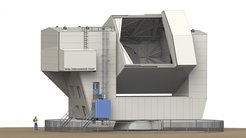Seeing How Stars Were Born: Fabrication of Six-metre CCAT-prime Telescope Has Begun
The telescope is scheduled to begin operation in 2021, enabling new insights into the ‘cosmic dawn’ – the birth of stars after the Big Bang – and the formation of stars and galaxies. The Max Planck Institute for Astrophysics (MPA) contributes to the construction of the telescope and MPA scientists will use the data to investigate the very early Universe.

Fabrication of the Cerro Chajnantor Atacama Telescope-prime (CCAT-p), a powerful telescope designed for the mapping of large areas of the nighttime sky, has begun, marking a major milestone in the project. The new telescope will be capable of mapping the sky at submillimeter and millimeter wavelengths. The CCAT Corporation is a partnership of Cornell University, the German CCAT Consortium, including the Universities of Cologne and Bonn as well as the Max Planck Institute for Astrophysics in Garching, and the Canadian Atacama Telescope Consortium (CATC), including several Canadian academic institutions.
“We are very excited to hear that the construction of the CCAT-p telescope has begun,” says Eiichiro Komatsu, director at the Max Planck Institute for Astrophysics. “The design of this telescope is completely novel, which allows for a huge field-of-view never achieved for a 6-m class sub-mm telescope before. Plus, the high altitude site allows us to make measurements at high frequencies which are inaccessible by any other facilities in the world.”
The six-metre telescope will be installed near the top of Cerro Chajnantor mountain in Chile’s Atacama Desert, with ‘first light’ being planned for the middle of 2021. CCAT-p will provide insights into the ‘cosmic dawn’ – when the first stars were born after the Big Bang – as well as how stars and galaxies form in areas of the universe in our proximity.
“One of the research areas where the CCAT-p telescope will have a large impact is the polarisation measurement of the cosmic microwave background,” Komatsu adds. “We can use high-frequency data from CCAT-p to measure and characterise the polarisation of dust emission in our Milky Way, and subtract it to measure fainter cosmic microwave background polarisation signals from gravitational waves in the early Universe. We are excited to be a part of this very unique project. New is good!”
In addition, MPA scientists will use the CCAT-p data to study physics of the epoch of reionisation using the so-called intensity mapping technique.
CCAT-prime is thanks in large part to support from the German Research Foundation (DFG) and the generosity of the American donor Fred Young. ‘It is exciting and satisfying that we have reached the initial construction phase’, Young remarked.
